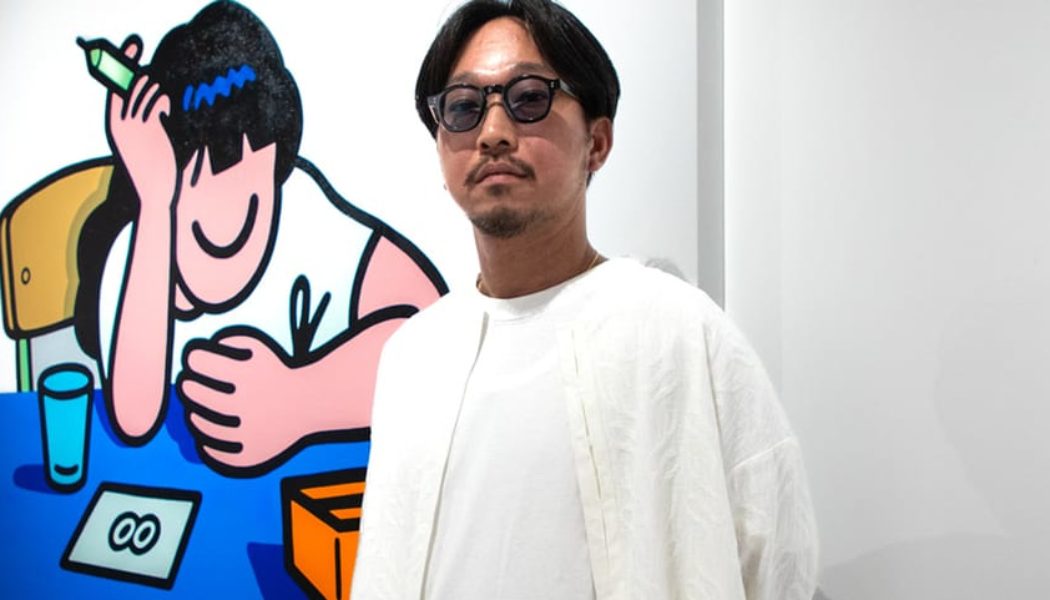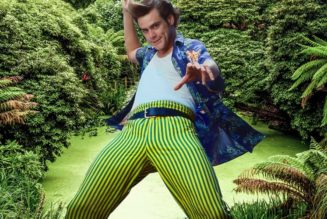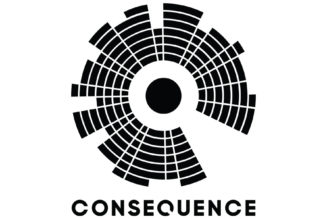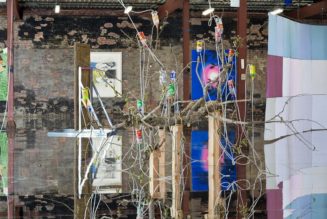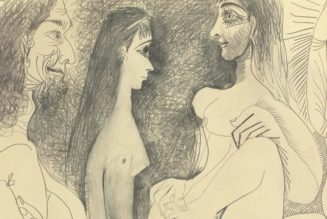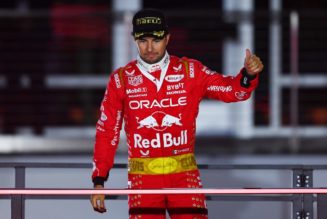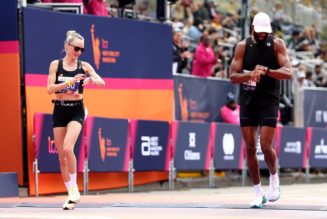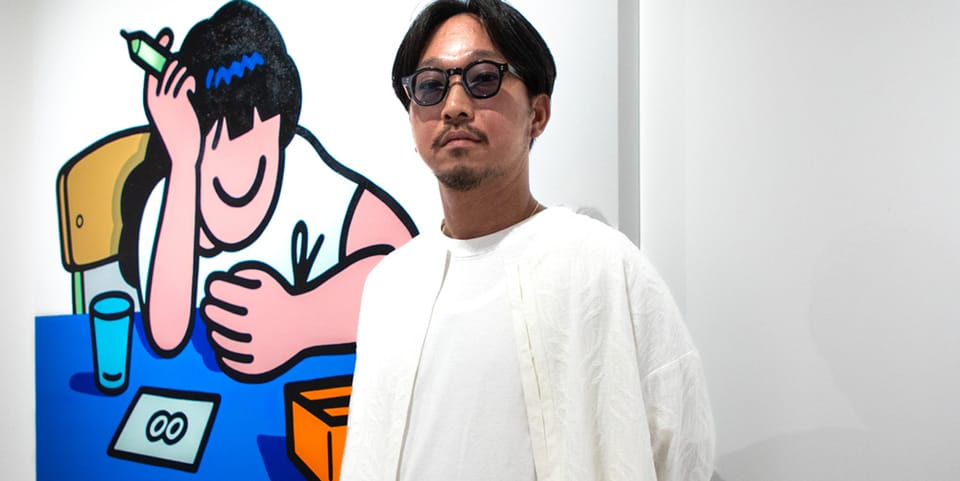
Contemporary Japanese artist face oka, who goes by face, just opened up his first overseas solo exhibition in Hong Kong over the weekend. Entitled “STORYBOARD”, the two-week showcase is presented in partnership with GALLERY TARGET and AllRightsReserved, taking place in a modern shop space at Central’s Landmark mall. This is also the latest installment of AllRightsReserved’s “MEET_PROJECT,” an ongoing initiative where they introduce artists of all disciplines via bespoke events.
“STORYBOARD” houses a collection of new artworks, spanning 25 acrylic paintings and a handful of sculptural pieces that center around the artist’s deep-rooted interest in the late ‘90s and ‘00s cinema. With the largest paintings measuring 162cm x 130cm, face has brought his pop characters and vivid scenery on such large scales for the first time.
Before “STORYBOARD” was unveiled to the public, face sat down with Hypebeast to shed light on his inspirations, creative process, and what he wants the audience to experience from his artwork.
What made you decide on hosting your first overseas solo art exhibition in Hong Kong?
It was actually AllRightsReserved who offered me the chance to host my solo exhibition in Hong Kong. We collaborated on figures before, and they wanted to showcase more of my work to the audience here.
There seems to be an overarching cinematic theme to the exhibition. Can you tell us a little more about the ideas behind “STORYBOARD?”
I like movies a lot, specifically the ones between the late ‘90s to the 2000s. Most of the movies I like from this era are Japanese. I wanted to recreate the mood and feel I experienced from the movies I enjoy through my art, and that’s how the “STORYBOARD” concept was born.
Are there any specific movies or directors that you feel particularly inspired by?
I wouldn’t say I’m inspired by any particular movies. But if we’re talking about directors, it’d be Takeshi Kitano. I love the mood and visuals of the Showa era and I’m intrigued by the retro atmosphere and bluish tones in his movies. It’s something that I want to reinterpret in my own style with pop colors.
What message do you want to convey to the audience with “STORYBOARD?”
I don’t like to emphasize or clearly define specific messages in my artwork. I guess if there is a sort of message, I want the audience to simply enjoy, and be immersed in my art. It doesn’t matter what kind of feelings you get out of it. One of the greatest pleasures for me, as an artist, is to have people interpret and freely expand on what I’ve created.
Your artwork mostly has a light-hearted and cartoon-like aesthetic to it, but it seems like there is so much more that lies beneath all the simplicity and vibrant colors.
Yes, that’s because Japanese manga and anime have been a huge influence and a huge part of my life. I’m also really into cartoons and comics from Western cultures, specifically from Europe and the US. As for the colors, I tend to not overthink or imbue any complex ideas into my color palettes, as I mostly just use whatever colors I like. I do love bright colors, so it makes me very happy to see visitors engage in the “pop-arty” mood my works offer.
“One of the greatest pleasures for me, as an artist, is to have people interpret and freely expand on what I’ve created.”
You also dedicated a few exhibits on Chainsaw Man. How did this collaboration come about?
I collaborated with Beams on a Chainsaw Man capsule collection a while back. They were working on a manga-related project, and were searching for artists to collaborate with. I’m a huge fan of Shonen Jump, especially series like Slam Dunk, Yu Yu Hakusho, and Hunter x Hunter. I’m from that generation of Shonen Jump readers, and it was a huge part of my youth, which was the reason I decided to partner up with Beams. After that, AllRightsReserved offered to bring my interpretation of Chainsaw Man characters into three-dimensional figures. Of course, I accepted that too. It was a fun project.
What was the creative process behind the artworks for “STORYBOARD?” Were there elements that were different from your usual approaches?
I bought and collected a lot of vintage magazines and comics just as I was working on this exhibition. I’d flip through all the pages, and I’ll cut out whatever catches my eye. These cut-outs are then used to create collages. I’ve made lots and lots of these collages, which I would then browse through again. From there, I’d combine the ones that feel like they could be made into a story or movie, which then becomes the idea and inspiration that forms the basis of a piece.
Aside from magazines and comics, I’d also take photos of the T.V. whenever something on it intrigues me. I take a lot of photos generally, which are all accumulated into stocks that I use to expand and create from.
Your research and art-making process seems very spontaneous.
That’s right, I don’t usually think too much when I’m making art. It’s pretty free.
How do you go about selecting the designs or artwork to use for the vinyl figures in this exhibition?
For instance, taxpayer II and taxpayer III are both inspired by my everyday life. These include but are not limited to my surroundings and belongings, like the gold jewelry I’m wearing now. The chairs and stools that the figures are sitting on are actual furniture from my studio too. I’m always conscious of interesting things around me, which I’ll extract and combine elements from to create something new.
Cigarettes are featured a lot in my work too. I’m a smoker, but it’s quite strict and restrictive to smoke in Japan right now. By incorporating cigarettes and the act of smoking itself in my work, I guess I’m rebelling against society in a way.
How would you describe your art in three words?
Face, Peace, and Imagine.
If you were to pick a piece from the exhibition that best describes your impression of Hong Kong, which would it be?
That would be The Saga of Organization. To be honest, I wasn’t thinking about Hong Kong when I created it. But looking at it now, I think it really captures the multicultural elements and cultures of the city. I also think it gives off the same busy vibe that you’ll experience in the markets in Wan Chai and Mong Kok.
You mentioned that you want the audience to interpret your artwork in their own ways. But is there a general concept of what you want each piece to express?
For this exhibition, I made paintings with no figures or characters in them, which is something I’ve never done before. This type of scenery is kind of like the mood shots and liminal spaces you see in movies. For example, Invasion by Toki Color actually depicts the landscape of my neighborhood. And if you look at Nothing Noticeable and Carolla in Ginza, both of these were actually depictions of places during me and my wife’s daily walks. I would envision my surroundings and imagine what kind of movies these would belong in. I still want the viewer to interpret the piece in their own ways, but I think these paintings serve as mini intermissions between the figure-oriented pieces in the exhibition.
When you apply these inspirations from your everyday life into your art, is it part of your intention to make it feel a little more abstract?
It does have a surrealistic feel, I guess. But it’s mainly because I’m a terrible liar. I can’t create images of places that I’ve never properly experienced or lived in before. So instead, I create these surreal landscapes based on my familiar environments. In a way, I guess what I want is to share my experiences through my art, specifically ones that I’ve actually lived through.
What other projects are you planning next?
I have a few collaborative projects coming up, mostly with long-time collaborators like adidas. I’m also planning to do an exhibition in Japan this year, which will be based around the idea of a “solo group exhibition.” For this, I’ll be experimenting with a variety of mediums, styles, techniques, and creating various kinds of artwork that feels like they’d belong in a group exhibition type of setting. It’ll be my first solo exhibition in Japan since the pandemic, and it will also be my biggest show to date.
face oka’s “STORYBOARD” solo exhibition will be on view at LANDMARK, Hong Kong until July 8, 2023.
LANDMARK
Shop 116, 1/F, LANDMARK,
15 Queen’s Road Central,
Central, Hong Kong
